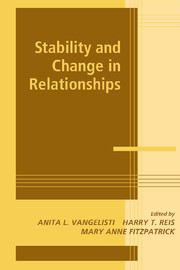Book contents
- Frontmatter
- Contents
- Contributors
- Preface
- PART ONE ACTORS: THE SCAFFOLDING OF STABILITY AND CHANGE
- 1 Change in Relationship Knowledge Representations
- 2 Personality Effects on Personal Relationships over the Life Span
- 3 An Intergenerational Model of Romantic Relationship Development
- 4 How Relationships Begin and End: A Genetic Perspective
- PART TWO BEHAVIORS: THE PROCESSES OF STABILITY AND CHANGE
- PART THREE CONTEXTS: SOCIAL ENVIRONMENTS FOR STABILITY AND CHANGE
- Author Index
- Subject Index
2 - Personality Effects on Personal Relationships over the Life Span
Published online by Cambridge University Press: 21 October 2009
- Frontmatter
- Contents
- Contributors
- Preface
- PART ONE ACTORS: THE SCAFFOLDING OF STABILITY AND CHANGE
- 1 Change in Relationship Knowledge Representations
- 2 Personality Effects on Personal Relationships over the Life Span
- 3 An Intergenerational Model of Romantic Relationship Development
- 4 How Relationships Begin and End: A Genetic Perspective
- PART TWO BEHAVIORS: THE PROCESSES OF STABILITY AND CHANGE
- PART THREE CONTEXTS: SOCIAL ENVIRONMENTS FOR STABILITY AND CHANGE
- Author Index
- Subject Index
Summary
Our personal relationships are shaped in part by our personality. Consider Jack, a single, outgoing, somewhat dominant, sometimes choleric man in his midtwenties, and Jill, a single, shy, sensitive, somewhat insecure, woman of the same age who would never drop an angry word about someone else. Each moves from the East Coast to the West Coast into a new position in the same company. How many new friends will each have after 1 month, and 5 years later? How will each one deal with parents and old friends who remain on the East Coast, after 1 month, and 5 years later? Will each find a love partner, and what will this relationship look like in 5 years? Readers will have no problems in generating expectations about the different social lives of Jack and Jill. For example, most would expect that Jack will report more new friends than Jill after 1 month, that Jack's friendships are less enduring than Jill's, and that Jack may be already divorced after 5 years whereas Jill may be still searching for a partner.
Thus, it is obvious that adults' personal relationships depend in part on their personalities. Although each individual relationship also depends on other factors – the personality of the relationship partner, external influences on the relationship, the intrinsic dynamics of the interaction history of the two, and not to forget simple chance – enduring personality characteristics such as temperament, IQ, and one's basic attitudes and values push each relationship in a particular direction at least slightly.
- Type
- Chapter
- Information
- Stability and Change in Relationships , pp. 35 - 56Publisher: Cambridge University PressPrint publication year: 2002
- 13
- Cited by



